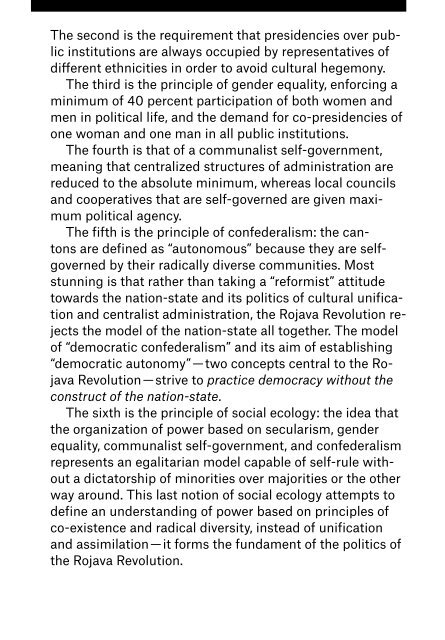Stateless Democracy
NWA5-Stateless-Democracy1.pdf?utm_content=buffer7beda&utm_medium=social&utm_source=twitter
NWA5-Stateless-Democracy1.pdf?utm_content=buffer7beda&utm_medium=social&utm_source=twitter
You also want an ePaper? Increase the reach of your titles
YUMPU automatically turns print PDFs into web optimized ePapers that Google loves.
The second is the requirement that presidencies over public<br />
institutions are always occupied by representatives of<br />
different ethnicities in order to avoid cultural hegemony.<br />
The third is the principle of gender equality, enforcing a<br />
minimum of 40 percent participation of both women and<br />
men in political life, and the demand for co-presidencies of<br />
one woman and one man in all public institutions.<br />
The fourth is that of a communalist self-government,<br />
meaning that centralized structures of administration are<br />
reduced to the absolute minimum, whereas local councils<br />
and cooperatives that are self-governed are given maximum<br />
political agency.<br />
The fifth is the principle of confederalism: the cantons<br />
are defined as “autonomous” because they are selfgoverned<br />
by their radically diverse communities. Most<br />
stunning is that rather than taking a “reformist” attitude<br />
towards the nation-state and its politics of cultural unification<br />
and centralist administration, the Rojava Revolution rejects<br />
the model of the nation-state all together. The model<br />
of “democratic confederalism” and its aim of establishing<br />
“democratic autonomy” — two concepts central to the Rojava<br />
Revolution — strive to practice democracy without the<br />
construct of the nation-state.<br />
The sixth is the principle of social ecology: the idea that<br />
the organization of power based on secularism, gender<br />
equality, communalist self-government, and confederalism<br />
represents an egalitarian model capable of self-rule without<br />
a dictatorship of minorities over majorities or the other<br />
way around. This last notion of social ecology attempts to<br />
define an understanding of power based on principles of<br />
co-existence and radical diversity, instead of unification<br />
and assimilation — it forms the fundament of the politics of<br />
the Rojava Revolution.<br />
2.<br />
The Yekîtiya Star Academy in Rimelan could be considered<br />
as the ideological heart of the Rojava Revolution,<br />
where these six defining points of the model of stateless<br />
democracy are theorized and taught. It’s already evening<br />
when I have the chance to visit the institution. The academy<br />
is organized by the Yekîtiya Star, the umbrella organization<br />
of the women’s movement in Rojava. I observe<br />
a silent classroom filled with young women soldiers and<br />
community organizers. The walls are covered with maps<br />
of Mesopotamia and Kurdistan, and images of past and<br />
present martyrs, including Arîn Mîrxan, who became a<br />
famous figure after she detonated herself to cover her<br />
retreating comrades and avoid capture by ISIS militants.<br />
The images are organized around a small wooden shelf,<br />
on which a Maria figure is placed — one of the very rare<br />
religious objects in the radically secular iconography of<br />
the Rojava Revolution.<br />
In the lecture of the teacher, Dorşin Akîf, I recognize the<br />
basic terminology that drives the revolution: democratic<br />
confederalism, democratic autonomy, communalism,<br />
women’s liberation, cooperatives, councils. These are the<br />
key terms that have been repeated to me by student organizers,<br />
teachers, soldiers, politicians, farmers, judges, and<br />
artists during my days travelling throughout the canton.<br />
Akîf’s speech is only interrupted for a brief moment by the<br />
sound of shots and an explosion. Later on I am told that<br />
ISIS has moved within three kilometers of the school, but<br />
the students don’t flinch for a moment. Their revolution<br />
takes place both in ideological education and armed struggle.<br />
After at least 30 days of ideological training, many of<br />
these young women will join the fight against ISIS, but not<br />
before they know what political model they are fighting for.<br />
When I speak with Akîf after class, she says:<br />
236–237


